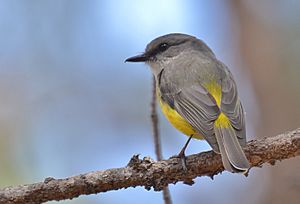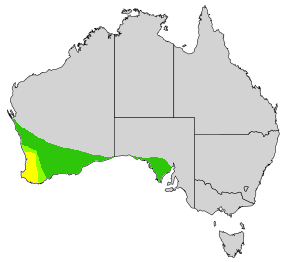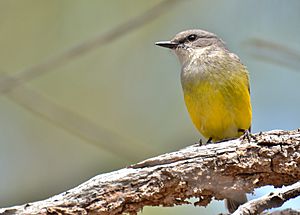Western yellow robin facts for kids
Quick facts for kids Western yellow robin |
|
|---|---|
 |
|
| Conservation status | |
| Scientific classification | |
| Genus: |
Eopsaltria
|
| Species: |
griseogularis
|
 |
|
| Range – subsp. griseogularis – yellow hybrid zone – light green subspecies rosinae – dark green |
|
The western yellow robin (Eopsaltria griseogularis) is a small bird from Australia. It belongs to the Australasian robin family, called Petroicidae. This bird was first described by John Gould in 1838.
Even though it's called a "robin," it's not closely related to the European robin or American robin. It's actually an early branch of the songbird group called Passerida. The western yellow robin is about 13.5 to 15.5 centimeters (5 to 6 inches) long. It has grey feathers on its back, head, and chest. It also has white streaks near its beak and under its eye. Its belly is a bright yellow. Both male and female birds look very similar.
There are two types, or subspecies, of the western yellow robin. One type, griseogularis, has a yellow rump (the area above its tail). The other type, rosinae, has an olive-green rump.
This bird lives in open eucalypt forests, woodlands, and scrublands. It likes places with lots of smaller plants and bushes. You can find it in the southwest of Western Australia and along the state's southern coast. It also lives on the Eyre Peninsula in South Australia.
Western yellow robins build cup-shaped nests in trees. They mainly eat insects, which they catch by pouncing from a low branch or by looking for food on the ground. The International Union for Conservation of Nature (IUCN) lists this bird as "least concern" for extinction. This means it's not currently in danger. However, its numbers have gone down in some areas.
Contents
About the Western Yellow Robin
What's in a Name?
The English bird expert John Gould first named the western yellow robin Eopsaltria griseogularis in 1838. He studied a bird found at the Swan River Colony. The name griseogularis comes from Latin words meaning 'grey' and 'throat'. Gould noted that this bird was common in the new colony. It was even part of the first animal collection for the London Zoo in the 1830s.
For a while, some experts thought the western yellow robin and the eastern yellow robin might be the same species. This was because they had similar calls and behaviors. However, studies of their DNA later showed that they are indeed two different species.
Another type of western yellow robin, Eopsaltria griseogularis rosinae, was named in 1912. It was named after Ethel Rosina White. This type has slightly different features.
The official name for this bird is "Western Yellow Robin." It's given by the International Ornithologists' Union. Remember, these Australian robins are not related to the robins you might know from Europe or America. They belong to their own special family, Petroicidae.
Old names for this bird included 'grey-breasted robin'. The 'shrike-' part was removed from its name in 1926. The local Nyungar people called it b'am-boore in 1840.
How to Identify This Bird
The western yellow robin is about 13.5 to 15.5 centimeters (5 to 6 inches) long. Its wingspan is about 24 to 27.5 centimeters (9.5 to 10.8 inches). It weighs around 20 grams (0.7 ounces). Males and females look alike. Their feathers don't change much with the seasons.
Their head, neck, and upper body are grey. Their throat is white, blending into a grey chest. They have black areas near their eyes and pale grey eyebrows. Their belly is bright yellow and stands out clearly from their chest.
The rump (area above the tail) is yellow in one type of the bird. In the other type, it's olive-green. Birds in between these two areas can have mixed colors. The rosinae type has longer wings and tail. It also has a shorter beak.
Young western yellow robins look different. They have dark brownish heads and backs with creamy white streaks. Their belly is white or off-white. As they grow, they lose these brownish feathers.
What Does It Sound Like?
The western yellow robin sings with long, whistling sounds. It often starts with two short notes. Its song is often heard before sunrise. Many people describe it as sounding a bit sad. It's a common sound in the forests of southwest Australia.
It also makes a scolding call, which sounds like ch-churr. When it's nesting time, the female makes a special call. This call is a long note with a short, deeper note at the end.
This bird doesn't look like any other bird in its area. The similar eastern yellow robin lives only in eastern Australia. Young western yellow robins can look a bit like young white-breasted robins. But young western yellow robins get yellow feathers on their bellies as they grow.
Where Western Yellow Robins Live
Habitat and Range
In Western Australia, you can find the western yellow robin south and west of a line from Kalbarri to Norseman. However, it's mostly missing from the coast between Dongara and Rockingham. It's rarely seen further north, like in Shark Bay.
Along the southern coast, it lives in scattered areas all the way to the South Australian border. In South Australia, it lives from Yalata east to the Eyre Peninsula. It also goes north to the Gawler Ranges. This bird usually stays in the same area and does not migrate.
The griseogularis type lives along the southwest coast of Western Australia. This is from Lancelin in the north to King George Sound in the southeast. The rosinae type lives from Jurien Bay and Tamala. It then spreads inland across the Wheatbelt and Goldfields. It also lives along the southeastern coast of Western Australia and on the Eyre Peninsula.
Western yellow robins live in eucalypt forests and woodlands. They also live in mallee and acacia-shrubland in drier areas. Studies show they like places with a thick tree canopy. They also prefer areas with a thick layer of fallen leaves and logs on the ground.
Logs and leaf litter provide homes for the insects these birds eat. A thick canopy also keeps the ground cooler. This helps insects to thrive. The presence of wandoo trees and Gastrolobium shrubs also means more leaf litter. These birds avoid areas near farms. This is because those places have less leaf litter. In tall jarrah-marri forests, they often stay in the middle layer of plants.
Western Yellow Robin Behavior
Social Life
Not much is known about how western yellow robins interact socially. They are usually seen alone or in pairs. Sometimes, they are in small groups. These groups are likely a mated pair with other birds helping them.
In autumn and winter, western yellow robins might join groups of other insect-eating birds. These groups can include Gilbert's honeyeater and grey fantail.
Reproduction and Life Cycle
Western yellow robins breed between July and early January. The busiest time is from September to November. Pairs usually try to raise two groups of chicks each season. The female chooses where to build the nest.
The nest is built in the fork of a tree or on a branch. They often choose eucalypt trees like marri, jarrah, or wandoo. Other trees they use include snottygobble, native cypress, Jacksonia, Acacia, or she-oak. In drier areas, they might use mallee eucalypts or quandong.
Nests are usually in the lower part of the tree canopy. This allows the birds to see the ground clearly. The leaves also hide them from predators flying above.
The nest is shaped like an open cup. It's made of bark strips, grass, and twigs. Spider webs and dried leaves help hold it together. The nest is about 7 to 9 centimeters (2.8 to 3.5 inches) high. The inner cup is about 3 to 5 centimeters (1.2 to 2 inches) wide.
The female builds the nest. The male and other helper birds feed her during this time. The eggs are thought to hatch after about fifteen days. They usually lay two or sometimes three eggs. The eggs are pale yellow or pearl-grey with red-brown marks. They are about 18–22 mm long.
Animals like the common brushtail possum and the grey shrikethrush sometimes eat the chicks. Other birds, like the pallid cuckoo and the shining bronze-cuckoo, lay their eggs in the robin's nest. The robin then raises the cuckoo chicks. The oldest recorded western yellow robin lived for eight years.
What They Eat
Western yellow robins mainly eat arthropods, especially insects. They sometimes eat seeds too. They hunt by watching the ground from branches or tree trunks. Then, they pounce on their prey, mostly on the ground.
One study found that western yellow robins caught 96% of their food on the ground. They often look for food near fallen logs. This is especially true in warmer months. Leaf litter near logs stays moist longer in warm weather. This means more prey for the birds.
Their hunting style is similar to European robins. They make short flights to the ground and then return to a branch. They don't seem to fly long distances.
Protecting the Western Yellow Robin
The IUCN Red List rated the western yellow robin as a "least-concern species" in 2016. This means it has a large population and a wide range. Even though its numbers are going down, it's not yet considered in danger of extinction.
However, there are threats to this bird. Global warming, especially severe weather, is a concern. Human changes to the land also harm or remove their habitat. The species has declined in parts of the Wheatbelt. This is likely due to losing suitable places to live.
By 2002, up to 93% of their habitat in the region was cleared. Much of what is left is damaged. Breaking up their habitat and livestock activities harm the leaf litter layer. Also, Gastrolobium plants are often removed because they are poisonous to cattle. This also affects the robin's habitat.
See also
 In Spanish: Petroica pechigrís para niños
In Spanish: Petroica pechigrís para niños



